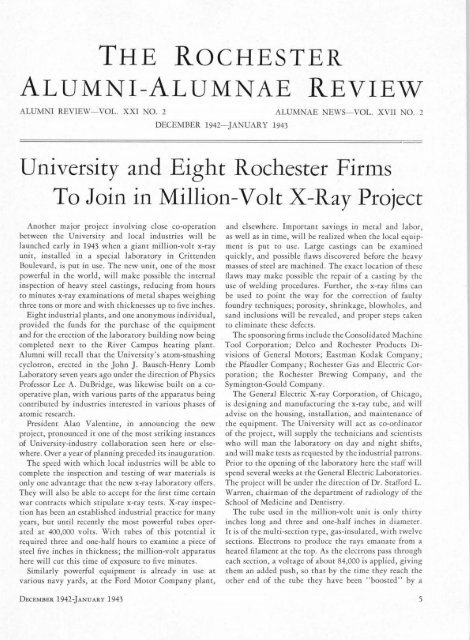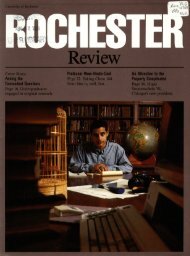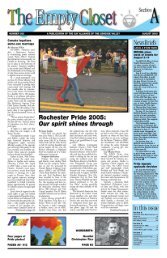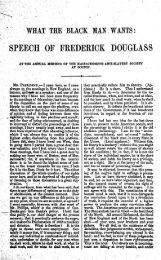Download PDF - University of Rochester Libraries
Download PDF - University of Rochester Libraries
Download PDF - University of Rochester Libraries
Create successful ePaper yourself
Turn your PDF publications into a flip-book with our unique Google optimized e-Paper software.
THE ROCHESTER<br />
ALUMNI-ALUMNAE REVIEW<br />
ALUM I REVIEW-VOL. XXI NO.2 ALUMNAE NEWS-VOL. XVII NO.2<br />
DECEMBER 1942-JANUARY 1943<br />
<strong>University</strong> and Eight <strong>Rochester</strong> Firms<br />
To Join in Million-Volt X-Ray Project<br />
Another major project involving close co-operation<br />
between the <strong>University</strong> and local industries will be<br />
launched early in 1943 when a giant million-volt x-ray<br />
unit, installed in a special laboratory in Crittenden<br />
Boulevard. is put in use. The new unit, one <strong>of</strong> the most<br />
powerful in the world, will make possible the internal<br />
inspection <strong>of</strong> heavy steel castings, reducing from hours<br />
to minutes x-ray examinations <strong>of</strong> metal shapes weighing<br />
three tons or more and with thicknesses up to five inches.<br />
Eight industrial plants, and one anonymous individual,<br />
provided the funds for the purchase <strong>of</strong> the equipment<br />
and for the erection <strong>of</strong> the laboratory building now being<br />
completed next to the River Campus heating plant.<br />
Alumni will recall that the <strong>University</strong>'s atom-smashing<br />
cyclotron, erected in the John J. Bausch-Henry Lomb<br />
Laboratory seven years ago under the direction <strong>of</strong> Physics<br />
Pr<strong>of</strong>essor Lee A. DuBridge, was likewise built on a cooperative<br />
plan, with various parts <strong>of</strong> the apparatus being<br />
contributed by industries interested in various phases <strong>of</strong><br />
atomic research.<br />
President Alan Valentine, in announcing the new<br />
project, pronounced it one <strong>of</strong> the most striking instances<br />
<strong>of</strong> <strong>University</strong>-industry collaboration seen here or elsewhere.<br />
Over a year <strong>of</strong> planning preceded its inauguration.<br />
The speed with which local industries will be able to<br />
complete the inspection and testing <strong>of</strong> war materials is<br />
only one advantage that the new x-ray laboratory <strong>of</strong>fers.<br />
They will also be able to accept for the first time certain<br />
war contracts which stipulate x-ray tests. X-ray inspection<br />
has been an established industrial practice for many<br />
years, but until recently the most powerful tubes operated<br />
at 400,000 volts. With tubes <strong>of</strong> this potential it<br />
required three and one-half hours to examine a piece <strong>of</strong><br />
steel five inches in thickness; the million-volt apparatus<br />
here will cut this time <strong>of</strong> exposure to five minutes.<br />
Similarly powerful equipment is already in use at<br />
various navy yards, at the Ford Motor Company plant,<br />
DECEMBER 1942-JANUARY 1943<br />
and elsewhere. Important savings in metal and labor,<br />
as well as in time, will be realized when the local equipment<br />
is put to use. Large castings can be examined<br />
quickly, and possible flaws discovered before the heavy<br />
masses <strong>of</strong> steel are machined. The exact location <strong>of</strong> these<br />
flaws may make possible the repair <strong>of</strong> a casting by the<br />
use <strong>of</strong> welding procedures. Further, the x-ray films can<br />
be used to point the way for the correction <strong>of</strong> faulty<br />
foundry techniques; porosity, shrinkage, blowholes, and<br />
sand inclusions will be revealed, and proper steps taken<br />
to eliminate these defects.<br />
The sponsoring firms include the Consolidated Machine<br />
Tool Corporation; Delco and <strong>Rochester</strong> Products Divisions<br />
<strong>of</strong> General Motors; Eastman Kodak Company;<br />
the Pfaudler Company; <strong>Rochester</strong> Gas and Electric Corporation;<br />
the <strong>Rochester</strong> Brewing Company, and the<br />
Symington-Gould Company.<br />
The General Electric X-ray Corporation, <strong>of</strong> Chicago,<br />
is designing and manufacturing the x-ray tube, and will<br />
advise on the housing, installation, and maintenance <strong>of</strong><br />
the equipment. The <strong>University</strong> will act as co-ordinator<br />
<strong>of</strong> the project, will supply the technicians and scientists<br />
who will man the laboratory on day and night shifts,<br />
and will make tests as requested by the industrial patrons.<br />
Prior to the opening <strong>of</strong> the laboratory here the staff will<br />
spend several weeks at the General Electric Laboratories.<br />
The project will be under the direction <strong>of</strong> Dr. Stafford L.<br />
Warren, chairman <strong>of</strong> the department <strong>of</strong> radiology <strong>of</strong> the<br />
School <strong>of</strong> Medicine and Dentistry.<br />
The tube used in the million-volt unit is only thirty<br />
inches long and three and one-half inches in diameter.<br />
It is <strong>of</strong> the multi-section type, gas-insulated, with twelve<br />
sections. Electrons to produce the rays emanate from a<br />
heated filament at the top. As the electrons pass through<br />
each section, a voltage <strong>of</strong> about 84,000 is applied, giving<br />
them an added push, so that by the time they reach the<br />
other end <strong>of</strong> the tube they have been "boosted" by a<br />
5
















